INFRARED – A RED-HOT TECHNOLOGY FOR POLICING
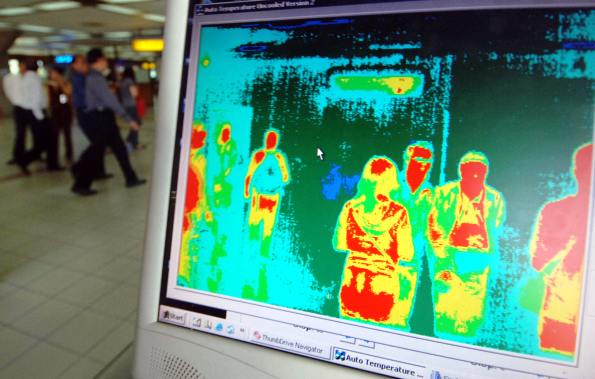
In Watertown, Massachusetts, USA, on a warm, beautiful April day in 2013, Henneberry realised that something was awry when he decided to service his boat, which was straddling in the backyard of his house. Having mounted the ladder after plopping it on the flank of the boat, he saw blood and an object bearing a resemblance to a crimped human trunk beneath the surface of the tarp with which he had swaddled the boat. The sight of which freaked him out, forcing him to dial 911. The authorities promptly dispatched a chopper outfitted with a state-of-the-art infrared camera called FLIR (forward-looking infrared) device. Hovering over the vicinity, the IR device on the chopper detected the heat impression of the second Boston Marathon bombing terror suspect, a 19-year-old Dzhokhar Tsarnaev on the boat. In no time, the police, ATF, SWAT and K-9 units swooped on 67 Franklin Street and took the bleeding Chechen terror suspect Dzhokhar Tsarnaev into their custody. The search for Dzhokhar Tsarnaev, a suspect in Marathon Boston bombing, considered one of the biggest manhunts in U.S. history, had come to a successful end mainly because of high-tech infrared cameras clamped on the chopper. Similarly, the French police employed infrared imaging systems in 2015 to get at the two brothers accused of the Charlie Hebdo massacre where they had scampered their way into the headquarters of the French satirical weekly journal Charlie Hebdo in Paris and slaughtered 12 people and injured 11 others.
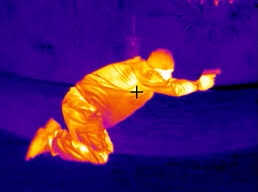 The infrared rays of our electromagnetic spectrum have been a subject of study for hundreds of years. Astronomer William Herschel in the 1700s began observing the infrared component of the spectrum which is invisible to the human eye, by peering at the sun with his telescope. The visible light in the electromagnetic spectrum resides between ultraviolet (UV) 400nm and infrared (IR) 700nm wavelengths. In comparison, the IR light occupies the electromagnetic spectrum between visible and microwaves between 700 to 15000nm on the electromagnetic spectrum. IR radiation, which is invisible, is perpetually being spewed by materials depending on their temperature. However, there is a subtle difference between IR systems and Thermal imaging cameras. Active IR systems use short wavelength infrared light, whereas Thermal imaging systems use mid- or long-wavelength IR energy. Besides, thermal imagers being passive only sense variations in heat.
The infrared rays of our electromagnetic spectrum have been a subject of study for hundreds of years. Astronomer William Herschel in the 1700s began observing the infrared component of the spectrum which is invisible to the human eye, by peering at the sun with his telescope. The visible light in the electromagnetic spectrum resides between ultraviolet (UV) 400nm and infrared (IR) 700nm wavelengths. In comparison, the IR light occupies the electromagnetic spectrum between visible and microwaves between 700 to 15000nm on the electromagnetic spectrum. IR radiation, which is invisible, is perpetually being spewed by materials depending on their temperature. However, there is a subtle difference between IR systems and Thermal imaging cameras. Active IR systems use short wavelength infrared light, whereas Thermal imaging systems use mid- or long-wavelength IR energy. Besides, thermal imagers being passive only sense variations in heat.

A variety of sources emit thermal energy. Many things, including living beings such as human beings, machinery and engines, create and emit heat either biologically or mechanically. Other things, like rocks, stones, land, vegetation, water etc. absorb the energy of the sun during the day and radiate it during the night. All things having a temperature above absolute zero emit heat, so even ice emits infrared energy. The thing we discern when we peek through a thermal camera is the intensity of infrared energy spewed by objects or living beings. Thermal imaging cameras also help police observe through light fog, light rain and snow.
Therefore, infrared cameras are facilitating the police to see things and people even under poor visibility and total darkness, particularly for monitoring areas at night and for capturing criminals lurking under cover of darkness. As was the case in Baltimore, Maryland, where police apprehended three armed men concealing themselves in a nearby dense forest after perpetrating an armed robbery by operating an infrared imaging camera clamped on a police chopper.
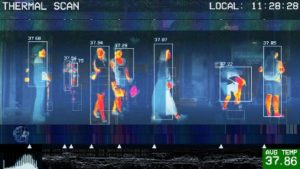
Similarly, in Lincolnshire, UK, a sobbing teenage girl who had been raped and didn’t know where she was made an SOS call. Lincolnshire police deployed a drone with an infrared imaging camera to track her down and get cops to her within minutes. Likewise, a man who had wrecked his car on a frigid winter night in Lincolnshire was saved from hypothermia when a police thermal-imaging drone discovered him in a deep ditch.
Furthermore, IR cameras are proving to be excellent gadgets for uncovering illicit drug labs, surreptitious cultivation of marijuana over land or inside buildings. Likewise, Choppers fitted with IR cameras are aiding SWAT operations, the search for fugitives, and for locating Naxalites or terrorists lurking or ambling in the jungles, deserts and other environments. IR cameras sweep extensive areas with ease and expose persons or things. IR devices also enable security teams to detect intruders in critical facilities such as nuclear and space facilities. IR devices seem to be better than tracking or sniffing dogs for trailing criminals, poachers, and for revealing concealed explosives and firearms both in open spaces or closed spaces and in the dark.
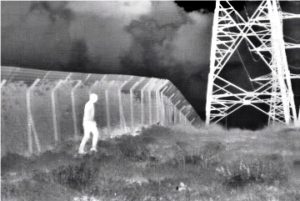 Not just in law enforcement, even in crime scene investigation, the current developments in infrared photography have spurred a new era. Without disturbing or compromising the scene of the crime, trace evidence such as blood and semen which is not detectable to the human eyes if available at the scene of the crime are revealing themselves in IR imaging.
Not just in law enforcement, even in crime scene investigation, the current developments in infrared photography have spurred a new era. Without disturbing or compromising the scene of the crime, trace evidence such as blood and semen which is not detectable to the human eyes if available at the scene of the crime are revealing themselves in IR imaging.
For instance, a few years ago, at a camping area near a waterfall. Three men were enjoying a meal around a fire when a disagreement over an issue between two of them led to an argument which eventually led to an armed assault resulting in a murder. The third friend, while watching the tragic scene unfold between his two friends, immediately called the police. But the knife-wielding suspect had taken to his heels immediately after the carnage and disappeared from the scene. Although the friend at the scene gave a blow by blow account of the incident to the police, detectives still had to figure out how it had transpired. To unravel what had happened, the detectives relied on infrared imaging. By scrutinising the bloodstain pattern analysis on the victim’s clothes, and the blood-spattered in the immediate vicinity, the police could conclude how the murder had unfurled.
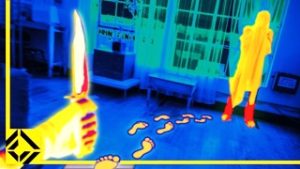 Another aspect of infrared technology which is finding immense use in forensics is infrared spectroscopy. Infrared spectroscopy analyses the chemical bonds within the molecules. The molecules have atoms which are in nonstop motion. Hence every atom or a chemical bond within a molecule vibrates within the infrared spectrum at a particular frequency, which is much like a fingerprint. When an infrared photon hits such an individual molecule having a similar vibrational frequency, it causes resonance which we can detect through spectroscopic techniques. This technique can pinpoint the exact chemical makeup of any molecule in any piece of the material evidence retrieved from the scene of a crime. For example, in case of a road accident, if a chip of paint of the offending hit-and-run vehicle gets found at the scene of the crime, infrared spectroscopic analysis of the paint sample would reveal it’s exact chemical makeup, which would lead to the manufacturer of the paint and further to the carmaker who used the colour. Thus, narrowing down the search for the make and colour of the suspect vehicle. With several more such applications, IR is proving to be a red-hot technology for policing.
Another aspect of infrared technology which is finding immense use in forensics is infrared spectroscopy. Infrared spectroscopy analyses the chemical bonds within the molecules. The molecules have atoms which are in nonstop motion. Hence every atom or a chemical bond within a molecule vibrates within the infrared spectrum at a particular frequency, which is much like a fingerprint. When an infrared photon hits such an individual molecule having a similar vibrational frequency, it causes resonance which we can detect through spectroscopic techniques. This technique can pinpoint the exact chemical makeup of any molecule in any piece of the material evidence retrieved from the scene of a crime. For example, in case of a road accident, if a chip of paint of the offending hit-and-run vehicle gets found at the scene of the crime, infrared spectroscopic analysis of the paint sample would reveal it’s exact chemical makeup, which would lead to the manufacturer of the paint and further to the carmaker who used the colour. Thus, narrowing down the search for the make and colour of the suspect vehicle. With several more such applications, IR is proving to be a red-hot technology for policing.
Finally, just as our bodies emit IR energy or thermal energy, which we are able to capture as images, we human beings radiate out our spiritual energy as an aura which we can glimpse by Kirlian photography. Hence, going within and cultivating a rich inner life can go a long way in helping us to sport a luminous aura of peace and serenity.
Source from: epaper/dtnext/chennai/dt:20.12.2020
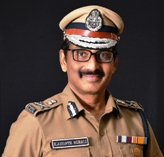 Dr.K. Jayanth Murali is an IPS Officer belonging to 1991 batch. He is borne on Tamil Nadu cadre. He lives with his family in Chennai, India. He is currently serving the Government of Tamil Nadu as Director / Additional Director General of Police, Vigilance and Anti-Corruption.
Dr.K. Jayanth Murali is an IPS Officer belonging to 1991 batch. He is borne on Tamil Nadu cadre. He lives with his family in Chennai, India. He is currently serving the Government of Tamil Nadu as Director / Additional Director General of Police, Vigilance and Anti-Corruption.


